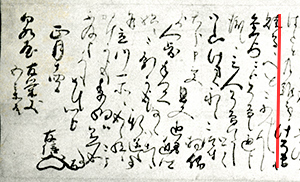Around 1702, Ogiwara Shigehide, kanjyo-bugyo (commissioner) of the Tokugawa shogunate, urged Tomoyoshi, the fourth head of the Sumitomo family, to propose concrete measures for promoting copper production in order to ease the financial difficulties of the shogunate. Viewing this as a golden opportunity to upgrade the mining infrastructure underpinning copper production, and moreover to secure the shogunate’s support for that endeavor, Tomoyoshi made a proposal consisting of five items to increase copper production.
These were: 1) construction of a drainage tunnel in the Tatsukawa Copper Mine, which is at a lower altitude than the Besshi Copper Mines, to reduce the cost of discharging spring water; 2) opening of a new route for the transport of goods to Niihama-ura bay; 3) use of a nearby forest owned by bannerman Hitotsuyanagi as a source of mine props and smelting fuel; 4) guarantee of Sumitomo’s perpetual right to manage the Besshi Copper Mines; and 5) provision of loans to fund ongoing operations.
Each of these five items was either a measure to reduce costs or a request for support for management. Before the critical negotiations on these matters got underway, Tomonobu, the third head of the Sumitomo family who had already retired, wrote to his heir Tomoyoshi and the head clerk Gohee about the need to be fully prepared for the negotiations with the shogunate. Tomonobu used the pithy expression “Tie a string to the leg of a grilled fowl” to convey the essence of his advice.
On might unpack the expression as follows: “Proceed with extreme caution. A grilled fowl won’t fly away but you should assume that it could. So tie a string to its leg. In this way, conduct the negotiations meticulously, making sure everything is nailed down.”
These negotiations had momentous implications for Sumitomo. If Tomoyoshi failed, the Tokugawa shogunate might seize the Besshi Copper Mines. Thus, Tomonobu reminded his son of the prime importance Sumitomo’s business philosophy accords to integrity and sound management.
Ever since the inception of Sumitomo’s business philosophy in the Edo era, steadfastness has been at the heart of this time-tested approach to commerce and industry. Tomonobu’s words enjoin us to exercise great care whenever we engage in business, always negotiating thoroughly and cultivating trust.

 EN
EN